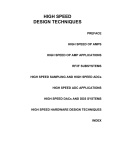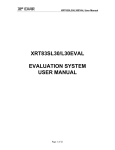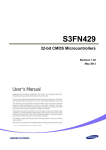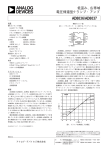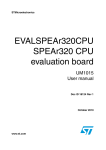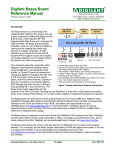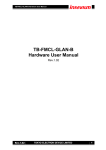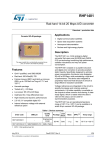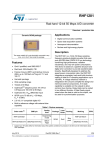Download Evaluation System User`s Manual
Transcript
xr XRD9818EVAL EVALUATION SYSTEM USER MANUAL REV. 1.0.0 XRD9818EVAL Evaluation System User Manual 1 xr XRD9818EVAL EVALUATION SYSTEM USER MANUAL REV. 1.0.0 1.0 FEATURES • XRD9818 28-pin TSSOP • FPGA - Xilinx Spartan II XC2S50 • In-System PROM XC18V01 • Graphical User Interface (GUI) with 25-pin Din Connector for a Standard Parallel Port Interface • Single Oscillator for Complete Timing Generation and Control • Analog Switch (EL4331) for Emulating CCD Signals • Clamping Amplifier (AD8036) for Reset Pulse Emulation • Line Clamp Control for 40,000 Pixels • De-Multiplexed Output Provided on a 17-pin Header including a Digital Output Clock 2.0 GENERAL DESCRIPTION The XRD9818EVAL board is designed to be a test platform that provides a means to evaluate the performance and functionality of the XRD9818ACG. The eval board contains a Xilinx FPGA that provides all timing signals required for the proper operation of the XRD9818ACG. The timing and functionality of the FPGA will adjust and conform to the mode of operation of the XRD9818ACG. A Graphical User Interface (GUI) allows the evaluation platform to be configured to setup and test the XRD9818ACG in any of its possible modes of operation. The evaluation system contains emulation circuitry that provides a pseudo CCD signal including a reset pulse if desired. XILINX SPARTAN II XC2S50 EXAR XRD9818ACG CCD Emulator EL4331 & AD8036 GUI Interface SRST SCS SCK SDI ADCLK BSAMP VSAMP LCLMP RED+ GRN+ BLU+ SDO XR_LOAD XR_SCLK XR_SDI DOUT[16:0] CNM8 ADCO[7:0] EMCLK RPCLK 16 DCLK MCLK Ocillator Master Clock FIGURE 1. SIMPLIFIED BLOCK DIAGRAM OF XRD9818EVAL 2 H e a d e r xr XRD9818EVAL EVALUATION SYSTEM USER MANUAL REV. 1.0.0 3.0 XRD9818EVAL APPLICATION PLATFORM The XRD9818EVAL is an evaluation PCB layout designed to test functionality and performance of the XRD9818. The evaluation platform is controlled via a GUI interface on a PC and requires only power supplies, inputs to the CCD emulator and test equipment (Logic Analyzer, Oscilloscope) in order to evaluate most of the functional and performance aspects of the XRD9818. The following sections describe the functional blocks that make up the XRD9818EVAL system. 3.1 Graphical User Interface (GUI) The GUI provides all serial port configurations for the XRD9818 plus options for controlling the XRD9818EVAL setup. To use the XRD9818 GUI simply run XRD9818.exe file and initiate "Start Test" located in the "TEST" pull down menu. FIGURE 2. OPEN XRD98181 GUI The GUI is broken into 7 sections that relate to various register functions of the XRD9818 and control features of the evaluation system: Color Options, Mode Options, Delay Registers, Polarity Options, Control Options, CPLD Options and Register Dump. Any changes become activated when the "Update" button is hit. FIGURE 3. XRD9818 (GUI) GRAPHICAL USER INTERFACE 3 xr XRD9818EVAL EVALUATION SYSTEM USER MANUAL REV. 1.0.0 Configurations can be saved and reloaded via the "File" pull down control located in the upper left hand corner of the GUI display FIGURE 4. 3.1.1 Color Options The XRD9818’s Gain and Offset controls for the individual channels: Red, Green and Blue (registers 0 thru 5), are controlled here. To modify the gain or offset values simply click on the bit you want to change. It will toggle between a "1" and a "0". The register value, in HEX, is shown just to the right. To zero out the register contents (reset to default value) simply set the "0" bit just to the right of the register value. For the definition of the gain and offset registers see the XRD9818 data sheet. 3.1.2 Mode Options This section sets the variables defined in the XRD9818’s MODE 1 register. Channel selection, clamp level, output data format, gain range select, imager mode and line clamp operation are defined by the pull down tabs. Not only is the XRD9818’s internal MODE 1 register is programmed but the FPGA will automatically adjust the system timing where needed to evaluate the device in the desired configuration. For the definition of the MODE 1 register see the XRD9818 data sheet. 3.1.3 Delay Registers They set the internal delays added to the BSAMP, VSAMP, ADCLK and ADCO (data output delay). Delays can be added to the sampling clocks (BSAMP, VSAMP & ADCLK) and data valid to help maximize performance of the XRD9818 and it’s flexibility to externally applied timing. For the definition of the delay registers see the XRD9818 data sheet. 3.1.4 Polarity Options & Control Options This section sets the variables defined in the XRD9818’s MODE 2 register. The polarity of the input timing to the XRD9818 can be individually set to be either active high (default) or active low. Power down and output enable are set via the Control Options interface. 3.1.5 Register Dump The internal register configuration of the XRD9818 can be read back via the register dump. When the "ReadBack" button is hit the register configuration is read and displayed, in hex. The registers are listed from top to bottom by address. A description of the readback operation is described in the XRD9818 data sheet. 3.1.6 CPLD options The channel output sample clock is defined by the Color Grab. The Xilinx FPGA provides a data valid clock to the data header (S5) to be used to sample the output data. For example, if the XRD9818 is being operated in 3-CH mode all three channel’s output data is sampled when the "Color Grab" is set to All Channels. Individual channel outputs can be sampled while in 3-CH operation by selecting the appropriate option. If "Red Channel" is selected, the CPLD supplies a sample clock only when the red channel data is available at S5. The "Reset CPLD" button is for use upon initialization of the evaluation platform or if a system reset is needed. 4 xr XRD9818EVAL EVALUATION SYSTEM USER MANUAL REV. 1.0.0 3.2 Spartan II FPGA (XC2S50) At the heart of the evaluation platform is the Spartan II. The FPGA provides the timing, control and pattern generation for the complete evaluation of the XRD9836. It reads the control information from the GUI and performs the appropriate write/read operation with the XRD9818. In addition to configuring the XRD9818 it will provide the appropriate timing signals to the evaluation system required to operate the XRD9818 in that mode. For example, if the XRD9818 is configured for 3-CH, CCD mode and nibble output operation the FPGA will provide the correct timing adjustments to the ADCLK, BSAMP, VSAMP, emulator clks, and 16bit out latch with sample clock so that the user does not need to adjust any of their equipment. 3.3 In-System PROM (XC18V01) The FPGA can be programmed in two ways. A standard JTAG header is provided to allow programming each time the XRD9818EVAL is powered up. Or, an in-system PROM is provided to automatically program the FPGA upon power up. The JTAG header allows flexibility to provide verilog source codes for customer verification. 3.4 25-DIN Parallel Connector for PC Interface The 25-DIN connector establishes the connection for the GUI control over the XRD9818EVAL through the parallel port of a PC. The GUI provides all serial port configurations XRD9818 plus options for controlling the XRD9818EVAL. When selecting options through the GUI, the program bursts the FPGA input with the pattern shown below in Figure 5. Please note that the pattern is not the same as the serial write pattern to the serial timing port of the XRD9818. The extra SCLK’s after SCS goes back high are required for a readback operation from the 9818’s internal registers. If the evaluation platforms is performing a readback operation the first clock after SCS goes high is required to latch the parallel data output from the 9818 and the next 10 clocks shift out the register content data, msb first. XRD9818 GUI Write/Read Timing LOAD SCLK SDI dc A3 A2 A1 A0 dc D9 D8 D7 D6 D5 D4 D3 D2 D1 D0 SDO D9 D8 D7 D6 D5 D4 D3 D2 D1 D0 D U M M Y Address D U M M Y Write Data Read Data FIGURE 5. XRD9818EVAL GUI INTERFACE TIMING 5 xr XRD9818EVAL EVALUATION SYSTEM USER MANUAL REV. 1.0.0 3.5 CCD Emulator Circuitry The emulation circuitry is intended to provide a pseudo CCD signal in order to evaluate the XRD9818 when configured for CCD operation. This is accomplished by the use of an analog switch (EL4331C) as seen in the evaluation board schematic . The basic function of the EL4331C (U5) is to switch each channels output between the its two inputs signals according to the polarity of the EMCLK timing signal. The inputs for each channel will be used to emulate the black reference level and video level of a CCD signal. If you look at the Figure 6 below you will see that the EMCLK connects the Black_Level (INxA - pins 3, 6, 12 of U5) input to the output when high and the Video input (INxB - pins 4, 5, 11 of U5) when the EMCLK is low. The resulting output signal as shown in the example timing for a Black Level=5V and a Video=4V is a signal toggling between 5V and 4V with the EMCLK. EMCLK BLACK_LEVEL 5V xxx(+)_VIDEO 4V OUTx 5V 4V FIGURE 6. BASIC FUNCTION OF ANALOG SWITCH To be able to test the XRD9818 for DNL & INL type specifications a sine wave generator can be connected to the Video input that has its peaks at 5V and 2V. This will cause the output of the XRD9818 to generate a digital sinewave that goes from zero code to full scale under the following conditions:CCD mode, GS=0, gain=1x, and offset reg adjusted to correct for any system offsets. A reset pulse can be added to the emulated CCD signal by the use of the clamping amplifier (U8). It operates on the same principle as the EL4331 but has a faster settling time. The reset pulse can be adjusted by the input levels to the device. The clocking is done by the RSCLK provided from the FPGA. An example of an emulated CCD signal with reset pulse is shown below in Figure 7. FIGURE 7. EXAMPLE OF CCD EMULTOR OUTPUT WITH RESET PULSE 6 xr XRD9818EVAL EVALUATION SYSTEM USER MANUAL REV. 1.0.0 3.6 Digital Output Interface The interface to a Logic Analyzer is a 17x2 header (S5). It provides 16 bits of data, latch clock and individual ground for each signal. The rising edge of the latch clock is intended to identify when data is valid. 4.0 EVALUATION BOARD - POWER, JUMPER AND HEADER INFORMATION TABLE 1: IDENTIFIER NAME DESCRIPTION B1 3V Eval Board Power (3.3V typically) B2 GND Eval Board Ground B3 5V_VCC Positive Power Supply for Pixel Emulator B4 -5V_VEE Negative Power Supply for Pixel Emulator J1 - J7 External Timing Jumpers Used when external timing is applied and FPGA is not used to supply system timing. J8, J9 & J10 Emulator Input Jumpers Series jumpers to connect/isolate XRD9818 analog inputs. J11 Emulator Reset Pulse Jumper Used to create Reset pulse as part of emulated CCD pixel input J12 & J13 XRD9818 Power Jumpers Used to Isolate the XRD9818 from Eval Board for IDD measurements. S1 Analog Input Header Used to ground XRD9818 analog inputs S2 Reference Header Test points for CAPP, CAPN, & CMREF S3 GPIO Header General purpose pins that can be used for debug of FPGA S4 JTAG Header JTAG header used to program PROM & FPGA S5 Data Output Header Logic analyzer header for reconstructed 16bit digital outputs P1 Parallel Port Interface 25-pin Din Connector standard parallel port interface for GUI control 5.0 REWORK INFORMATION Jumper near U3 (PROM) to supply power (VDD3V) to pins 18, 19 & 20. 7 XRD9818EVAL EVALUATION SYSTEM USER MANUAL xr REV. 1.0.0 6.0 XRD9818EVAL SCHEMATICS FIGURE 8. XRD9818 & SPARTAN II J1 6 5 4 J2 J3 R4 J4 SMB5 LOAD R5 J5 R6 J6 R7 2 50 AGND JTAG S4 SMB2 BSAMP 1 2 3 R10 1 14 2 15 3 16 4 17 5 18 6 19 7 20 8 21 9 22 10 23 11 24 12 25 13 SMB3 VSAMP P1 AGND AGND 50 AGND SMB4 LCLMP C5 0.1uf DVDD 50 AGND AGND OPEN CONNECTOR DB25_0 AGND 5 6 4 17 18 20 19 VCC VCC VCCO U3 R21 470 470 D0/DATA CLK OE/RST CE CEO XC18V01 36 SMB R17 470 R15 470 SMB8 GND R16 R14 11 TMS TCK TDI TDO 50 R18 D7 D6 D5 D4/CF D3 D2 D1 R19 SMB6 SDI R8 300 AGND AGND R11 short R12 short R13 short 1 3 8 10 13 12 9 14 7 15 2 16 AGND 50 4.7K 36 AGND 50 GND VCC SMB7 SCLK CLK U4 AGND R9 5 4.7K R20 VDD3v 4 8 91 79 77 76 75 74 109 111 106 39 37 68 72 69 38 142 2 32 34 88 18 15 + J7 VDD3v LCLMP VSAMP BSAMP ADCCLK GPIO_9 GPIO_8 GPIO_7 GPIO_6 GPIO_5 GPIO_4 GPIO_3 GPIO_2 GPIO_1 GPIO_0 ADCO0 ADCO1 ADCO2 ADCO3 ADCO4 ADCO5 ADCO6 ADCO7 XR_LOAD XR_SDI XR_SCLK AGND DOCLK DOUT15 DOUT14 DOUT13 DOUT12 DOUT11 DOUT10 DOUT9 DOUT8 DOUT7 DOUT6 DOUT5 DOUT4 DOUT3 DOUT2 DOUT1 DOUT0 EMCLK RESETCLK Spartan II FPGA XC2S50 AGND VDD3v MCLK SDO SRST SDI SCS SCK M0 M1 M2 DIN CCLK INIT DONE PGM DOUT TMS TCK TDI TDO GCLK0 GCLK2 GCLK3 U2 VDD2v5 AGND 1 + open 50 2 + 1 + 2 + 1 + 2 + 1 + 2 1 + Oscillator_0 26 23 22 21 20 19 13 12 11 10 7 6 5 4 3 122 123 124 129 130 131 132 133 136 137 139 141 65 63 62 60 59 58 57 56 50 49 48 47 46 44 43 41 40 LCLMP VSAMP BSAMP ADCLK LOAD SDI SCLK S3 1 2 3 4 5 6 7 8 9 10 GPIO HEADER 1 2 3 4 5 6 7 8 9 10 11 12 13 14 15 16 17 1 S5 t TP4 34 33 32 31 30 29 28 27 26 25 24 23 22 21 20 19 18 HEADER 17X2 g VDDA3v AGND VDDA3v 2 AGND AGND 1 2 3 4 5 6 7 8 9 10 11 12 13 14 BLU+ GRN+ AGND CMN- U1 AVDD CAPP CMREF RED+ LCLMP SDI DVDD LOAD DGND ADCLK ADCO[2] ADCO[3] ADCO[4] ADCO[5] ADCO[6] ADCO[7] AVDD AGND CAPN VSAMP SCLK BSAMP ADCO[0] XRD9818 ADCO[1] 28 27 26 25 24 23 22 21 20 19 18 17 16 15 VDDD3v AGND TP2 TP1 1 1 C2 C1 1nf 1nf 1nf 1nf 1 C3 TP3 C4 t t t g g g 2 2 2 1 2 3 S2 HEADER 3 RESETCLK EMCLK AGND AGND BAR AGND AGND BAR AGND Title C Size Date: Monday, March 24, 2003 XRD9818EVAL Document Number XRD9818 & Spartan II S1 AGND HEADER 4X2 Sheet Red Input Green Input Blue Input Common Ref Input CMREF CAPP CAPN 1 of 3 H:\ORCAD\PROJECTS\9818\9818EVAL_3A.DSN AGND 2 R3 + 2 1 + AGND 1 A Rev 8 1 2 3 4 2 1 16 35 36 53 70 71 90 107 108 127 144 VDDo VDDo VDDo VDDo VDDo VDDo VDDo VDDo VDDo VDDo VDDo VDDo VSS VSS VSS VSS VSS VSS VSS VSS VSS VSS VSS VSS VSS VSS VSS VSS 8 7 6 5 1 R2 + 2 + 1 + 9 14 24 55 82 92 97 125 VDDi VDDi VDDi VDDi VDDi VDDi VDDi VDDi 8 17 25 33 45 52 61 73 81 89 98 110 119 128 135 143 SMB1 ADCLK VDD3v R1 VEE5v AGND OUT1 OUT2 + 0 EMCLK U5 EL4331C OUT3 1 8 9 J UMPER 10uf + C19 R33 50 AGND C23 0.1uf R25 R27 R42 0 0 0 CMN- R29 AGND J9 J8 J10 2 VCC5v AGND IN1A IN1B IN2A IN2B IN3A IN3B A/B PD J11 AGND 0.1uf C20 AD8036 6 U8 AGND R30 VCC5v + - R36 140 C22 10uf 0.1UF (high => black level, low => video level) 3 4 6 5 12 11 16 14 3 2 R38 0 1 2 BLACK LEVEL 10K R23 VCC5v AGND C18 0.1uf R32 130 C21 0.1uf R37 open 1 2 R22 AGND RED+_VIDEO R24 AGND GRN+_VIDEO R26 AGND BLU+_VIDEO R28 AGND RESETCLK R34 AGND open C8 AGND 2 AGND 1 C6 AGND SMB13 0.01UF VEE5v J UMPER J UMPER J UMPER Red Input Green Input Blue Input Common Ref Input Monday, March 24, 2003 Sheet 2 of Pixel Emulator Circuitry with Reset Pulse Docume nt Numbe r XRD9818EVAL 3 H:\ORCAD\PROJECTS\9818\9818EVAL_3A.DSN Title B Size Date: A Rev 9 0.1UF C9 AGND OPEN 13 VEE GND 10 OPEN 0.01UF C7 1 15 VCC GND 2 SMB9 SMB10 SMB11 SMB12 OPEN OPEN OPEN GND 7 8 5 RESET PULSE LEVEL R31 AGND BLACK LEVEL R35 AGND OPEN OPEN 7 4 SMB14 SMB15 xr XRD9818EVAL EVALUATION SYSTEM USER MANUAL REV. 1.0.0 FIGURE 9. CCD EMULATOR 0.1uF C39 C25 0.1uF C50 0.1uF C40 0.01uF C26 0.1uF C51 0.1uF C41 0.01uF C27 0.1uF C52 0.1uF C42 C35 0.1uF C28 0.1uF C53 0.1uF C43 0.1uF C34 0.1uF C24 + + 1 1 + + 2 2 B2 AGND 0.1uF POWER AND BYPASS CIRCUITRY C32 BANNANA PLUGS AGND C46 + + C31 22uF VDD2v5 AGND AGND B3 C29 MHOLE M4 MHOLE M3 MHOLE M2 MHOLE M1 + 10uF 1 1 1 VCC5v Title B Size B4 C30 Power & Decoupling Document Number Wednesday, April 30, 2003 XRD9818EVAL 1 VEE5v Sheet 3 of 3 H:\ORCAD\PROJECTS\9818\9818EVAL_3A.DSN EXAR EXAR U15 10uF -5V_VEE 2 470 R40 4 5V_VCC OUT + + + OUT 470 U9 LT1174 IN C44 C54 C56 AGND 1 GND VDD3v 3 D1 5.6V GND 1 3V B1 + LED D2 0.1uF J12 + + J13 10uF AGND CAPP CAPN R41 1 Date: A Rev 10 AGND VDD3v AGND VDD2v5 AGND R39 1 2.2uF 1 2 VDDA3v 0.1uF C49 AGND VDDD3v 0.1uF C38 1 2.2uF 2.2uF 470 CMREF C45 C55 C57 0.1uF 0.1uF 0.1uF C48 1 2.2uF 10uF 10uF 0.1uF 0.1uF + XRD9818EVAL EVALUATION SYSTEM USER MANUAL xr REV. 1.0.0 FIGURE 10. POWER AND BYPASS CIRCUITRY C36 0.1uF C37 C33 C47










